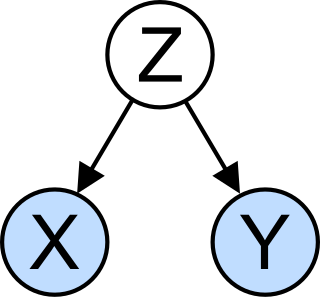Analysis of variance (ANOVA) is a collection of statistical models and their associated estimation procedures used to analyze the differences among group means in a sample. ANOVA was developed by statistician and evolutionary biologist Ronald Fisher. In the ANOVA setting, the observed variance in a particular variable is partitioned into components attributable to different sources of variation. In its simplest form, ANOVA provides a statistical test of whether the population means of several groups are equal, and therefore generalizes the t-test to more than two groups. ANOVA is useful for comparing (testing) three or more group means for statistical significance. It is conceptually similar to multiple two-sample t-tests, but is more conservative, resulting in fewer type I errors, and is therefore suited to a wide range of practical problems.
Empirical research is research using empirical evidence. It is a way of gaining knowledge by means of direct and indirect observation or experience. Empiricism values such research more than other kinds. Empirical evidence can be analyzed quantitatively or qualitatively. Quantifying the evidence or making sense of it in qualitative form, a researcher can answer empirical questions, which should be clearly defined and answerable with the evidence collected. Research design varies by field and by the question being investigated. Many researchers combine qualitative and quantitative forms of analysis to better answer questions which cannot be studied in laboratory settings, particularly in the social sciences and in education.
Observational error is the difference between a measured value of a quantity and its true value. In statistics, an error is not a "mistake". Variability is an inherent part of the results of measurements and of the measurement process.

Observation is the active acquisition of information from a primary source. In living beings, observation employs the senses. In science, observation can also involve the recording of data via the use of scientific instruments. The term may also refer to any data collected during the scientific activity. Observations can be qualitative, that is, only the absence or presence of a property is noted, or quantitative if a numerical value is attached to the observed phenomenon by counting or measuring.

Statistics is a branch of mathematics dealing with data collection, organization, analysis, interpretation and presentation. In applying statistics to, for example, a scientific, industrial, or social problem, it is conventional to begin with a statistical population or a statistical model process to be studied. Populations can be diverse topics such as "all people living in a country" or "every atom composing a crystal". Statistics deals with all aspects of data, including the planning of data collection in terms of the design of surveys and experiments. See glossary of probability and statistics.

An experiment is a procedure carried out to support, refute, or validate a hypothesis. Experiments provide insight into cause-and-effect by demonstrating what outcome occurs when a particular factor is manipulated. Experiments vary greatly in goal and scale, but always rely on repeatable procedure and logical analysis of the results. There also exists natural experimental studies.
Self-perception theory (SPT) is an account of attitude formation developed by psychologist Daryl Bem. It asserts that people develop their attitudes by observing their own behavior and concluding what attitudes must have caused it. The theory is counterintuitive in nature, as the conventional wisdom is that attitudes determine behaviors. Furthermore, the theory suggests that people induce attitudes without accessing internal cognition and mood states. The person interprets their own overt behaviors rationally in the same way they attempt to explain others' behaviors.
The Hawthorne effect is a type of reactivity in which individuals modify an aspect of their behavior in response to their awareness of being observed. The original research at the Hawthorne Works in Cicero, Illinois, on lighting changes and work structure changes such as working hours and break times was originally interpreted by Elton Mayo and others to mean that paying attention to overall worker needs would improve productivity. Later interpretations such as that done by Landsberger suggested that the novelty of being research subjects and the increased attention from such could lead to temporary increases in workers' productivity. This interpretation was dubbed "the Hawthorne effect".
The Barnum effect, also called the Forer effect, is a common psychological phenomenon whereby individuals give high accuracy ratings to descriptions of their personality that supposedly are tailored specifically to them, that are in fact vague and general enough to apply to a wide range of people. This effect can provide a partial explanation for the widespread acceptance of some paranormal beliefs and practices, such as astrology, fortune telling, aura reading, and some types of personality tests.
A nocebo effect is said to occur when negative expectations of the patient regarding a treatment cause the treatment to have a more negative effect than it otherwise would have. For example, when a patient anticipates a side effect of a medication, they can suffer that effect even if the "medication" is actually an inert substance. The complementary concept, the placebo effect, is said to occur when positive expectations improve an outcome. Both placebo and nocebo effects are presumably psychogenic, but they can induce measurable changes in the body. One article that reviewed 31 studies on nocebo effects reported a wide range of symptoms that could manifest as nocebo effects including nausea, stomach pains, itching, bloating, depression, sleep problems, loss of appetite, sexual dysfunction and severe hypotension. Mental states such as beliefs and expectations can strongly influence the outcome of disease, the experience of pain, and even success of surgery.

Response bias is a general term for a wide range of tendencies for participants to respond inaccurately or falsely to questions. These biases are prevalent in research involving participant self-report, such as structured interviews or surveys. Response biases can have a large impact on the validity of questionnaires or surveys.

A scientific control is an experiment or observation designed to minimize the effects of variables other than the independent variable. This increases the reliability of the results, often through a comparison between control measurements and the other measurements. Scientific controls are a part of the scientific method.

In statistics, a confounder is a variable that influences both the dependent variable and independent variable, causing a spurious association. Confounding is a causal concept, and as such, cannot be described in terms of correlations or associations.
In statistics, controlling for a variable is the attempt to reduce the effect of confounding variables in an observational study or experiment. It means that when looking at the effect of one variable, the effects of all other variable predictors are taken into account, either by making the other variables take on a fixed value or by including them in a regression to separate their effects from those of the explanatory variable of interest.
A test method is a method for a test in science or engineering, such as a physical test, chemical test, or statistical test. It is a definitive procedure that produces a test result. In order to ensure accurate and relevant test results, a test method should be "explicit, unambiguous, and experimentally feasible.", as well as effective and reproducible.
The following is a glossary of terms. It is not intended to be all-inclusive.

Predictably Irrational: The Hidden Forces That Shape Our Decisions is a 2008 book by Dan Ariely, in which he challenges readers' assumptions about making decisions based on rational thought. Ariely explains, "My goal, by the end of this book, is to help you fundamentally rethink what makes you and the people around you tick. I hope to lead you there by presenting a wide range of scientific experiments, findings, and anecdotes that are in many cases quite amusing. Once you see how systematic certain mistakes are—how we repeat them again and again—I think you will begin to learn how to avoid some of them".
Passenger Environment Survey (PES) is a quality-control type survey used by a number of transit agencies to rate and monitor performance. Generally a PES would include items such as cleanliness, litter, appearance, temperature, graffiti, trash cans, and other quality issues affecting customer perception and quality of the riding experience. There is usually a quality control criteria, and dedicated surveyors are used to gather data that summarize into periodic ratings.
Observational methods in psychological research entail the observation and description of a subject's behavior. Researchers utilizing the observational method can exert varying amounts of control over the environment in which the observation takes place. This makes observational research a sort of middle ground between the highly controlled method of experimental design and the less structured approach of conducting interviews.







